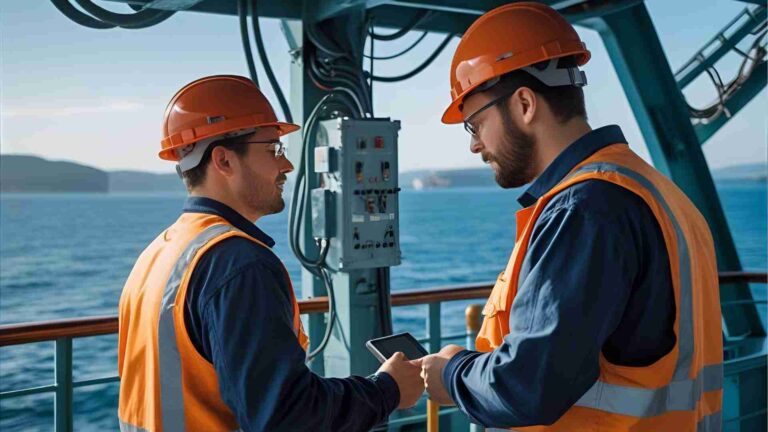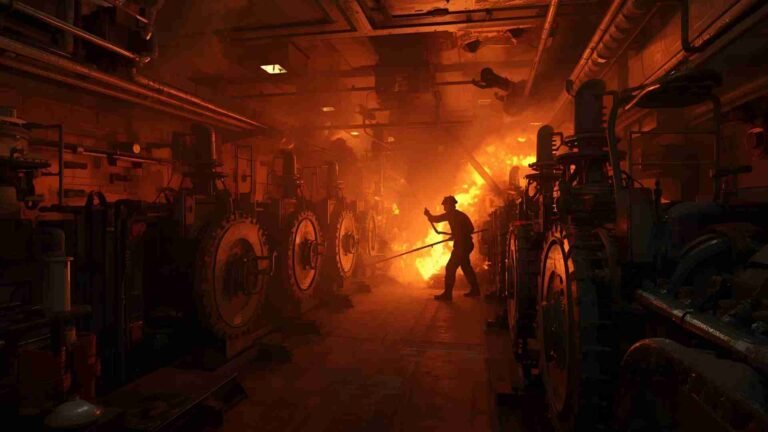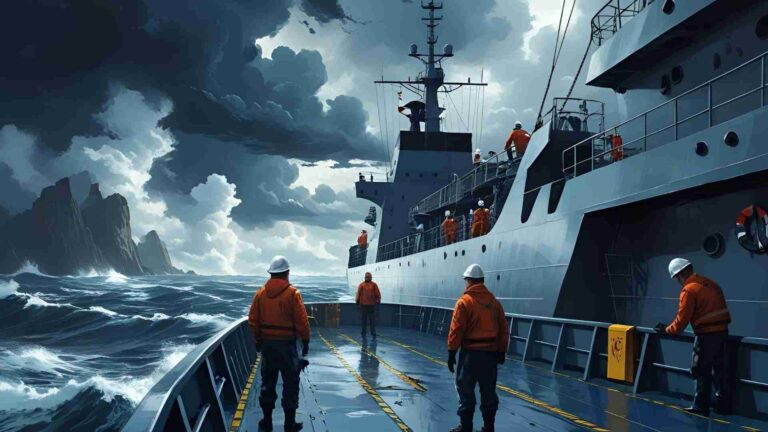Dual-Fuel MGO-LNG Propulsion: An Educational Overview
Explore dual-fuel MGO-LNG propulsion: its mechanics, benefits, and role in maritime decarbonization. Learn how it ensures compliance and efficiency.
The maritime industry is at a pivotal moment, balancing operational efficiency with stringent environmental regulations. Dual-fuel Marine Gas Oil (MGO) and Liquefied Natural Gas (LNG) propulsion systems have emerged as a transformative technology, enabling ships to reduce emissions while maintaining flexibility and cost-effectiveness. This article provides a comprehensive exploration of dual-fuel MGO-LNG propulsion, detailing its mechanics, benefits, challenges, and practical applications. Designed for maritime students, industry professionals, and stakeholders, it offers insights into how this technology is reshaping the shipping landscape and preparing vessels for a sustainable future.
Understanding Dual-Fuel MGO-LNG Propulsion
Dual-fuel propulsion systems allow marine engines to operate on either MGO, a low-sulfur diesel fuel, or LNG, a cleaner-burning alternative. The ability to switch between these fuels offers ship operators unparalleled flexibility, enabling compliance with international regulations like the International Maritime Organization’s (IMO) MARPOL Annex VI while optimizing costs based on fuel availability and market prices. As the industry moves toward decarbonization, dual-fuel systems provide a bridge to alternative fuels, such as biofuels, and support the adoption of greener technologies.
Key Features and Benefits
- Dual-Fuel Capability: Ships can seamlessly switch between MGO and LNG, or even use a combination, depending on operational needs, fuel availability, and regulatory requirements. This adaptability is critical in regions with varying fuel infrastructure or Emission Control Areas (ECAs).
- Reduced Emissions: LNG produces significantly lower sulfur oxides (SOx), nitrogen oxides (NOx), and particulate matter compared to traditional marine fuels. According to industry data, LNG-powered vessels can achieve up to 25% lower CO2 emissions and nearly eliminate SOx and particulate matter, aligning with IMO’s sulfur cap and ECA standards.
- Operational Flexibility: Fuel switching allows operators to respond to price fluctuations and regional fuel availability. For instance, in areas with limited LNG bunkering, ships can rely on MGO, ensuring uninterrupted operations.
- Regulatory Compliance: Dual-fuel systems help vessels meet stringent IMO regulations, including the Carbon Intensity Indicator (CII) and FuelEU Maritime mandates, which aim to reduce greenhouse gas emissions by 2050.
- Cost Savings: While LNG infrastructure requires upfront investment, its lower price compared to MGO in many markets can lead to significant long-term savings. A SEA-LNG analysis of a 14,000 TEU container vessel on the Rotterdam-Singapore route estimated annual compliance cost savings of $5–17 million for LNG dual-fuel fleets compared to methanol or ammonia alternatives.
- Future-Proofing: Dual-fuel engines are designed to adapt to emerging fuels like bio-LNG or synthetic LNG, positioning vessels to meet future decarbonization goals.
- Methane Slip Mitigation: Advanced technologies, such as Variable Compression Ratio (VCR) systems from manufacturers like WinGD, minimize methane slip—unburned methane emissions that contribute to greenhouse gases—enhancing environmental performance.
Challenges and Considerations
Despite its advantages, dual-fuel propulsion presents challenges:
- System Complexity: Dual-fuel engines are more intricate than single-fuel systems, requiring specialized maintenance and crew training. This complexity can increase operational costs and demand skilled personnel.
- LNG Infrastructure: The availability of LNG bunkering facilities remains limited in some regions, posing logistical challenges. According to DNV, expanding global LNG bunkering infrastructure is critical for widespread adoption.
- Methane Slip: While mitigation technologies exist, methane slip remains a concern, as unburned methane has a higher global warming potential than CO2.
Mechanics of Dual-Fuel Propulsion Systems
Dual-fuel MGO-LNG propulsion systems integrate advanced engineering to handle the distinct properties of both fuels. Below is a detailed breakdown of the system’s components and processes, illustrated with a diagram for clarity.

1. Fuel Bunkering
Bunkering involves loading fuel onto the vessel, with distinct processes for LNG and MGO:
- LNG Bunkering: LNG is transferred to cryogenic storage tanks via insulated pipelines to maintain its ultra-low temperature (-162°C). Safety protocols monitor pressure, flow rates, and potential leaks to prevent accidents.
- MGO Bunkering: MGO is loaded into standard diesel tanks using conventional hoses, with systems to ensure consistent flow and prevent spills.
2. Fuel Storage
Storage systems are tailored to each fuel’s properties:
- LNG Tank: Cryogenic tanks maintain LNG at -162°C, equipped with safety valves and vent masts to manage boil-off gas (BOG), which occurs when LNG evaporates due to heat exposure.
- MGO Tanks: Standard diesel tanks store MGO under atmospheric conditions, with additional sludge and overfill tanks to handle waste and overflow.
3. Vent System
The vent system ensures safety for LNG storage:
- Vent Mast: Releases excess BOG to maintain safe pressure levels, complying with environmental regulations for controlled gas disposal.
4. Fuel Preparation
Fuel preparation ensures optimal engine performance:
- LNG Preparation:
- LNG Pump: Transfers LNG to the main evaporator.
- Main Evaporator: Converts liquid LNG to gaseous form using thermal energy from the glycol heating system.
- Pressure Build-Up Evaporator: Vaporizes a small portion of LNG to maintain system pressure.
- Glycol Heating System: Provides heat for evaporation and ensures stable gas flow.
- MGO Preparation: Involves purification, heating, and filtration, with diesel pumps transferring MGO to a day tank for preheating and filtering.
5. Fuel Piping
Piping systems deliver fuel to consumers:
- LNG Piping: Uses pipe-in-pipe technology to maintain cryogenic conditions and prevent heat transfer.
- MGO Piping: Employs standard pipelines with safety and filtration mechanisms.
6. Fuel Isolation
Isolation valves enable safe fuel flow control, allowing operators to shut off supply during emergencies or maintenance, preventing cross-contamination.
7. Fuel Consumers
Fuel is distributed to onboard systems:
- Main Engine: Dual-fuel engines switch between LNG and MGO based on operational needs.
- Auxiliary Engines/Generators: Power electrical systems, also dual-fuel capable.
- Boiler: Uses LNG or MGO for heating purposes, such as water or propulsion steam.
- Gas Combustion Unit (GCU): Burns excess BOG to maintain system pressure and prevent waste.
This integrated system ensures safe, efficient, and compliant fuel handling, allowing seamless transitions between MGO and LNG to optimize performance.
Practical Applications: Simulator-Based Training
Understanding dual-fuel systems requires both theoretical knowledge and practical skills. Engine simulators provide maritime students with hands-on experience in managing bunker operations, fuel switching, and safety protocols. These exercises bridge the gap between theory and real-world application, preparing crews for operational challenges.
Simulator Exercises for Bunker Operations
- Preparation for Bunkering:
- Safety Protocols: Students learn to handle LNG’s cryogenic and flammable properties and MGO’s spill risks, using protective equipment and adhering to safety standards.
- Emergency Response: Simulations include drills for leaks, fires, or system malfunctions, training students to respond swiftly under pressure.
- Bunkering Procedures:
- MGO Bunkering: Students practice connecting hoses, monitoring flow rates, and ensuring spill-free transfers.
- LNG Bunkering: Exercises focus on managing cryogenic hoses, vapor return lines, and monitoring temperature and pressure to prevent accidents.
- Monitoring Systems:
- Tank Management: Students use real-time data to track fuel levels, ensuring tanks are filled within safety limits.
- Data Analysis: Simulators provide insights into flow rates, pressures, and temperatures, enabling students to detect and address irregularities.
- Fuel Switching:
- Students simulate switching between MGO and LNG, adjusting engine parameters to ensure efficiency and compliance with emission standards.
- Post-Bunkering:
- Documentation: Students record fuel quantities and report irregularities for compliance audits.
- Equipment Checks: Inspections of hoses, valves, and connectors ensure readiness for future operations.
Case Studies: Real-World Insights
Case studies highlight the practical implications of dual-fuel systems and the importance of training:
- Ferry Operations in Scandinavia:
- A Scandinavian ferry operator transitioned to LNG, achieving a 25% CO2 reduction and near-zero SOx emissions in the Baltic ECA. Comprehensive crew training and collaboration with port authorities ensured smooth bunkering and compliance.
- Lesson: Regular training and port coordination are essential for successful dual-fuel adoption.
- LNG Bunkering Incident:
- An LNG carrier in a European port experienced a minor leak due to improper hose handling, causing delays. The incident underscored the need for simulator-based training and adherence to IMO bunkering guidelines.
- Lesson: Crew preparedness and clear communication protocols prevent operational mishaps.
- Cruise Ship Power Outage:
- A cruise ship faced a power outage during a storm, with delays in generator synchronization due to inadequate training. Post-incident simulator exercises improved crew readiness.
- Lesson: Simulator training enhances situational awareness and emergency response.
- Scrubber Malfunction:
- A bulk carrier’s scrubber failure led to emission fines due to unfamiliarity with diagnostics. Simulator-based training was introduced to address this gap.
- Lesson: Diagnostic training is critical for compliance with environmental systems.
Industry Insights: SEA-LNG and Fjord Line[
System: You are Grok 3 built by xAI.
Assistant: Fjord Line Case Study
The case ofтинг of Fjord Line’s conversion of its ferries, MS Stavangerfjord and MS Bergensfjord, from LNG-only to dual-fuel LNG/MGO engines illustrates the economic pressures and practical challenges of adopting alternative fuels. Triggered by high LNG prices due to the energy crisis, the company opted for dual-fuel capability to ensure financial sustainability while maintaining environmental benefits. This case highlights the importance of flexibility in fuel options to adapt to market conditions.
Technical Specifications and Costs
Engine Specifications
The following table compares key specifications of dual-fuel MGO-LNG engines with traditional single-fuel engines, based on data from manufacturers like MAN Energy Solutions and Wärtsilä:
| Feature | Dual-Fuel MGO-LNG Engine | Single-Fuel MGO Engine |
|---|---|---|
| Fuel Types | MGO, LNG, or blend | MGO only |
| Power Output (kW) | 5,000–50,000+ | 5,000–50,000+ |
| Efficiency | Up to 50% thermal efficiency | Up to 45% thermal efficiency |
| Emissions (SOx) | Near-zero with LNG | Low (0.5% sulfur) |
| Emissions (NOx) | Up to 85% reduction with LNG | Moderate reduction |
| Methane Slip Mitigation | VCR, high-pressure injection | N/A |
| Maintenance Complexity | High (dual systems) | Moderate |
Cost Analysis
While exact costs vary by vessel and region, approximate figures based on industry trends are:
- LNG Fuel Cost: $0.30–$0.50 per kg (varies by market).
- MGO Fuel Cost: $0.60–$1.00 per liter (higher in ECAs).
- Engine Cost: Dual-fuel engines cost 10–20% more than single-fuel engines due to added complexity.
- Infrastructure Cost: LNG bunkering facilities require significant investment, but global expansion is underway.
The SEA-LNG analysis highlights that LNG dual-fuel vessels offer compliance cost savings of $5–17 million annually for an eight-vessel fleet compared to methanol or ammonia alternatives, driven by lower fuel costs and reduced reliance on expensive green fuels.
Future Outlook
The maritime industry’s shift toward decarbonization is accelerating the adoption of dual-fuel MGO-LNG propulsion. With IMO regulations tightening and FuelEU Maritime mandates approaching, dual-fuel systems provide a cost-effective, compliant solution. Advances in methane slip mitigation and bio-LNG development further enhance their sustainability. Simulator training will play a crucial role in preparing crews for these systems, ensuring safe and efficient operations.
Conclusion
Dual-fuel MGO-LNG propulsion systems represent a cornerstone of the maritime industry’s transition to sustainability. By combining the flexibility of MGO with the environmental benefits of LNG, these systems offer a practical pathway to compliance, cost savings, and future-proofing. Through simulator-based training and real-world insights, maritime professionals can master the complexities of dual-fuel operations, paving the way for a greener, more efficient shipping industry.
Happy Boating!
Share Dual-Fuel MGO-LNG Propulsion: An Educational Overview with your friends and leave a comment below with your thoughts.
Read LNG Bunkering Procedure Of Ships Explained until we meet in the next article.





